Power-up Your Product Messaging With Heuristic Evaluation
Author & Editor
Copywriting Team Lead
Published on: Jan 21, 2021 Updated on: May 17, 2024

Table of Contents
When it comes to product messaging and copywriting, a competitor analysis is often the bane of every digital marketing strategy. Specifically, studying certain elements that make your competitors stand out on search and social media, and using that data to your advantage. And if you thought that was hard enough, wait ‘til you get a load of keyword research and A/B Testing.
Despite a change of pace in digital marketing trends for 2021, expect these quantitative approaches to always be part and parcel of your digital marketing frameworks and strategies.
However, the common pain point of these key processes is that it can be time-consuming and even lead to solutions that don’t precisely tackle your target audience's pain points when it comes to product messaging. You’re shooting arrows in the dark if you think a certain copy can lead to conversion without the quantitative and qualitative data to back up your claim.
As a leading digital marketing agency in the Philippines, we’ve adopted audit criteria through Heuristic Evaluation which eliminates the need to conduct a long exhaustive study on your website’s product messaging. Specifically, this is an audit process that examines the features of a page through a set of product messaging principles known as heuristics.

The key findings in a heuristic analysis allow you to identify certain elements in a website that cohesively presents its products in a way that translates to an increase in leads and conversions. It could be a persuasive CTA, an eye-catching banner, a keyword-centric copy, or just a smoothly transitioned marketing funnel page architecture.
You can easily determine this all thanks to a heuristic evaluation. From here, you’ll be able to develop conversion-critical copywriting and combine design elements to produce a well-structured website that can perform better than the top organic result on SERP.
Before anything else, take note that this article will only focus on product messaging and copywriting since heuristic evaluation is a broad topic branching out to specific key features of your digital product. In a nutshell: Anything that goes through a framework-based or structured-based evaluation done by experts is considered a heuristic evaluation.
Well, on with the show then.
What is Heuristic Evaluation?
Originally, a heuristic evaluation is an expert review of a website to ensure that it is user-friendly. It aims to identify common user issues encountered on a website and resolve them to improve the overall experience and satisfaction within the page.
Over time, the concept of heuristic evaluation has branched from just focusing on the usability of a digital product to focus on different conversion-focused brand elements such as product messaging and content structure of a website.
The criteria used for a heuristic review is through an established set of principles known as heuristics. The evaluation method cross-references these heuristic principles to a product or website to check specific elements that can be improved to increase leads and conversions.
How legitimate can the results of a heuristic review get?
For a heuristic evaluation to become valid, at least three but not more than five evaluators must perform the process on the same website. These typically involve subject matter experts (SMEs) who have a firm understanding of a certain niche or industry which in this case, are those adept at SEO, content, and product messaging.
As the old adage goes: “It’s easier to find something when you know what you’re looking for in the first place.” Indeed, when you know what specific features can correlate to conversion, the process of evaluating and applying those changes in your brand website makes the process so much easier.
What It’s Not
Although Heuristic Evaluation is somewhat similar to user testing, don’t commit the error of mistaking one for the other. A general difference between the two is that the former is conducted by SMEs, while the latter is done by the users themselves.
Just by looking at the data collected from both parties, you can already tell the difference between an expert’s insight as compared to a user’s.
Also, don’t mistake heuristic evaluation as the be-all and end-all of your competitor analysis. Yes, it has a vital role to play in your audit but that doesn’t mean keyword research, backlink analysis, and on-page and off-page SEO are no less important. Take into consideration that each strategy has its own merits in the soup. (For a more detailed discussion on this topic check out this ultimate guide we’ve made to understanding SEO).
Why Do You Need Heuristic Evaluation?
As mentioned earlier, it can get quite tedious to perform an exhaustive study of you and your competitors’ websites from scratch.
Aside from that, there’s also the question of what features of product messaging you should look out for in a website that can drive traffic and ROI. And while you can follow copywriting best practices for your brand, there should be a data-driven component existent in your process that eliminates that ‘gut feeling’ method of writing conversion-critical copies.
Because of a set criteria, which a heuristic review already provides, you are able to zero in on these elements and leverage the results to your website improvements. No more blank stares on a web page since you already know what to look for prior to the evaluation.
Obviously, this saves your time and budget and provides vital information to be included in your overall competitor analysis.
How Vital is it in your Digital Marketing Strategy?
A heuristic evaluation is actually two sides of the same coin when it comes to formulating a two-tail approach for your digital marketing strategy. While A/B testing handles the quantitative approach of determining what makes a user become a lead or conversion, heuristic evaluation is the qualitative counterpart that identifies the needs of a user when they check out your brand website’s copies and product messaging.
Don’t get us wrong, data should be at the forefront of every digital strategy and quantitative steps such as competitor analysis, keyword research, and A/B testing make it possible to collect such information that harnesses customer intelligence. This allows you to determine what keywords to use, search intent to satisfy, ads to create, and features to optimize to drive relevant organic traffic to your website.
But what happens if after all those key steps you’ve done, your website is still not drawing the traffic and ROI you’re targeting?
Customer theory suggests that the problem may lie in the lack of understanding the needs of your target audience, specifically, alleviating their pain points to achieve a goal. As you get to identify who your customers are through market research, you must also become aware of why they’re looking for your particular product or service to resolve their problem.

If you can’t identify and agitate that pain point at the start, then you’re going to have a hard time convincing them later on why they should choose your brand aside from the other available options in the market.
It’s one thing to know who they are and what keywords to attract them with to your website, and it’s another to give them a meaningful customer journey that addresses their pain points until they eventually make a profitable decision.
A heuristic evaluation arms you with the qualitative arsenal to evaluate the user experience and product messaging in a webpage and harvest that data to improve page elements that translate to improved lead generation and conversions.
It can be a header copy that comprehensively orients them of what the page is about, a thought-provoking CTA that compels you to click, or a content structure that comprehensively tackles customer fears and objections.
No amount of quantitative data can be able to determine these elements except through the watchful eye of evaluators who perform the heuristic analysis.
How to Conduct a Heuristic Evaluation for Copywriting and Product Messaging
Now that you know the importance of having a heuristic evaluation in your digital marketing repertoire, it’s time to teach you the basics of what you need to do to comprehensively conduct an analysis of your own.
The following are general rules of thumb when conducting your evaluation for a precise and valid conclusion:
1. Preliminary requirements.
Before you start your heuristic evaluation, you have to satisfy the following requirements first to make your review sound and valid. Much like how academic papers are graded and passed, your assessment should undergo a minimum of three but not more than five SME evaluators skilled in SEO, content, and product messaging of the website’s main product or service.

The ideal worksheet for a heuristic evaluation is an excel spreadsheet as it will contain the evaluator score, review details, and suggestions for improvement. It is advised that separate excel sheets per SME be given as to not influence their scores and review with each other. At the end of the heuristic evaluation, the findings will then be collated and analyzed.
2. Search for page competitors.
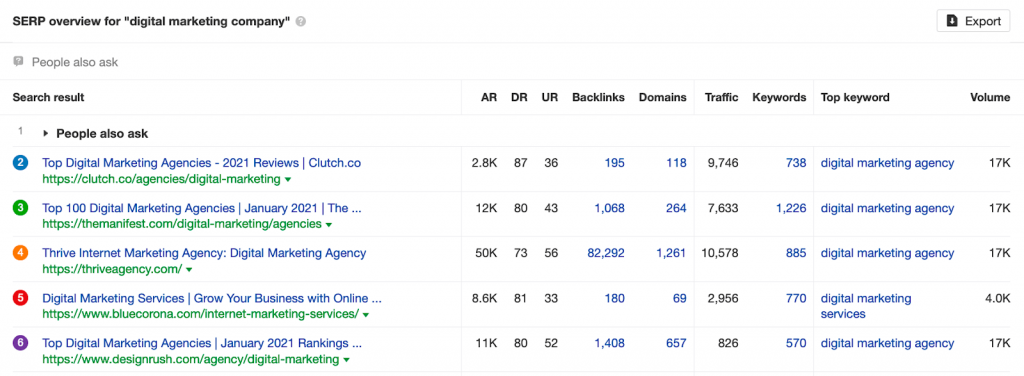
While you can do a comprehensive keyword analysis to see who’s ranking for your target keywords, another method can be looking through the top organic results for your niche and industry. There’s a reason they’re ranking on SERP, which is what you’ll try to find out with your heuristic review.
There’s no limit as to how many competitors you can perform a heuristic evaluation on but make sure that you only include those that are gaining relevant traffic on Search.
3. Be specific on what to analyze.
Once you’ve established WHO to evaluate, it’s essential that you also determine WHAT page you’re trying to evaluate on their website. Assess your needs to find out if it’s a home page, landing page, or product page you’re trying to perform your heuristic review on.
Take into consideration as well the search intent of the page you’re evaluating to see if it’s aligned with what you’re trying to produce. There is no point in doing a review of a page whose intent is purely transactional if yours is meant to be informational. Assess the quality, type, and intent of the website to save time in your heuristic evaluation.
4. Comprehensively read through the whole page.
Now, this is the meat-and-potatoes of your whole heuristic evaluation. This step requires SMEs to meticulously read through the whole page, evaluating its product messaging through each copy, CTA, UX design elements, and SEO features.
Even external and internal links are no exemption to the review, as it checks out the interlinking and backlink quality of the page's content. Information and contact sheets are also thoroughly tested to check how responsive the web design is.
If you have an existing page, it’s worth noting that a heuristic analysis should also be done for that as well. This enables you to evaluate a side-by-side comparison of you and your competitors’ page in the process.
Don’t leave the transaction page out. Review the input labels, payment methods, and trust badges since these elements can make or break a possible conversion if not executed correctly.
5. Score your review based on criteria.
Once the review is completed, it’s time to score how the page was able to satisfy the heuristic requirements. As mentioned earlier, there are many types of heuristic evaluations out there but for this article, we will solely be focusing on product messaging. The review for each heuristic checklist varies with a Likert scale score ranging from poor to very satisfactory.

At the end of the evaluation, the scores will be collated and averaged to see which page ranks first on the review.
6. Detail your findings.
Of course, each score presented in the heuristic evaluation requires a corresponding explanation as to why the evaluator gave that value. Knowing that this is an expert review, expect the findings to be comprehensive, thorough, and fully detail the features that make it a top organic result on search.
7. Give feedback on improvement.
After each score and comment, suggestions for improvement are required to conclude a heuristic evaluation because it leverages the strengths and weaknesses of a competitor’s page to your advantage. Much like how SEO competitor analysis works, this step checks areas in your SEO that you can pursue to improve your SERP performance and page ranking.
This is why step #4 is essential. Going back, a side-by-side comparison makes it easier for you to check out what your existing page has or lacks to boost your brand’s product messaging.
8. Tally and Validate Evaluator Score.
Finally, to establish the credibility of the heuristic evaluation, a Fleiss’ Kappa is required to determine the level of inter-rater agreement between the evaluators. Since this is an expert review, the score of each evaluator should achieve a level of agreement that can be verified through statistical correlation.
The result of the Fleiss’ Kappa lets you know if the overall evaluator scores for each conversion requirement goal are consistent and reliable. It can be measured through a nominal scale ranging from 0.01 to 1 with corresponding interpretations of poor to very substantial agreement.
With this, you’re already halfway through doing a comprehensive heuristic evaluation of your own. Keep in mind these essential steps to ensure that your review is sound and valid.
Heuristic Evaluation Criteria for Copywriting and Product Messaging
For product messaging we’ve managed to adapt Momoko Price’s Copy Teardown process to our heuristic evaluation which focuses on satisfying a set of conversion requirement goals to ensure that the website optimizations we do are able to draw traffic and boost page ranking.
Here are the 7 conversion requirement goals of Momoko’s checklist that your product messaging should focus on. A Likert scale with a nominal score ranging from 0 (Not Done), 1 (Needs Improvement), and 2 (Executed Well) will be given per checklist item. Note that each score given should have a corresponding comment and suggestion from the three (to five) SMEs who will conduct the heuristic analysis.
Below are the following conversion requirement goals on product messaging that your heuristic evaluation checklist should have:
Orient user upon entrance
This conversion requirement goal is fixated on the first thing that the user will see or read as they enter the website. You’re familiar with the phrase “first impressions count”, right? Well, that is just what this heuristic principle is all about. It studies how effective a page is in informing the user of its intent and purpose at first glance without having to scroll through the whole content to find out what it is.
The reason being is that realistically speaking, not everyone has the capacity or luxury to extensively read your page from top to bottom. This lever ensures that your audience is able to determine the relevance of your website within seconds just by looking at your header titles and SERP copies.
These are the following checklist items to answer for this conversion requirement goal:
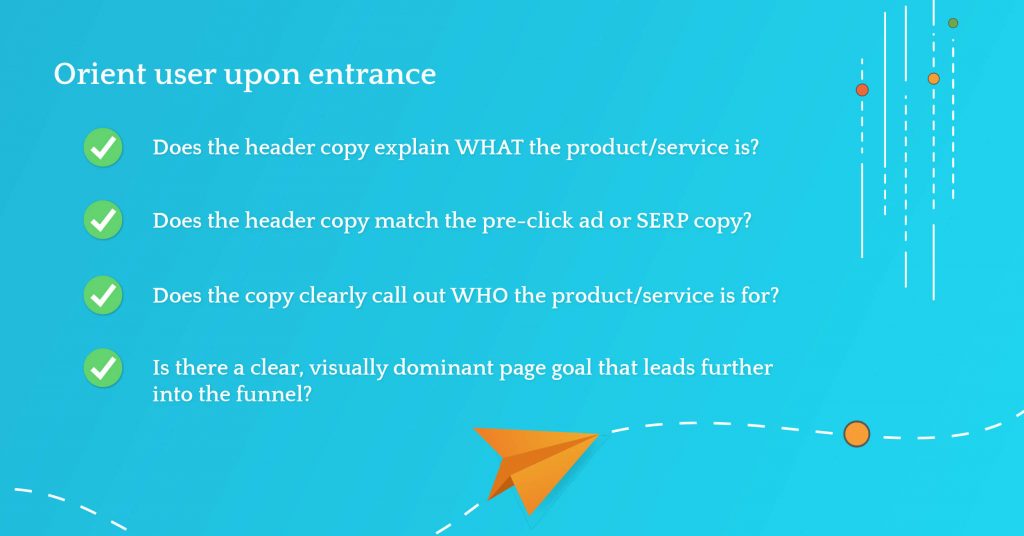
Appeal to user motivation
Essentially, what you are trying to gauge in this lever is the ability of your product messaging to state a desired goal or pain point and focus your copies in bridging the acquisition of your services as the solution. For this conversion requirement goal, the page content should vividly express copies that resonate with the user as they scroll through the page.
At this point, it should be clear what the website is trying to offer to alleviate a pain point or achieve a desired outcome. There is no point in scrolling through a website that does not make the audience realize why they need a certain service or product.
These are the following checklist items to answer for this conversion requirement goal:

Convey unique value
If there’s a bitter pill you should learn to swallow by now, it’s that you’re not the only brand offering your particular set of products or services. That is why a Unique Value Proposition (UVP) is important because it explains why your product is better than the best option to address your customers’ pain points. It essentially answers the question of what makes it stand out in the market.
Dig out the UVP of the product or service offered on a competitor’s website and study how it was packaged and presented to the user. At the same time, you should also review your brand’s UVP and see if it was translated comprehensively and effectively on your website.
These are the following checklist items to answer for this conversion requirement goal:
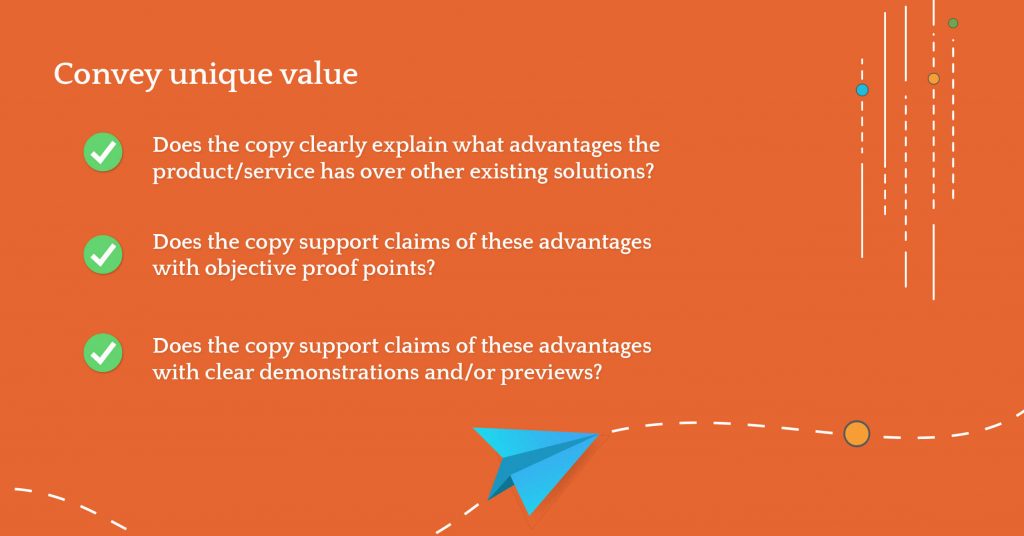
Establish credibility
Of course, you wouldn’t trust anybody to provide a service to you that easily, right? You want to get your money’s worth and make sure that you’re getting what you bargained for and more.
A key solution to address this pain point is to establish credibility and build trust with the user. You can do this through customer testimonials, social proof, trust badges, and the like. Make sure to check these features out on the website being evaluated.
These are the following checklist items to answer for this conversion requirement goal:
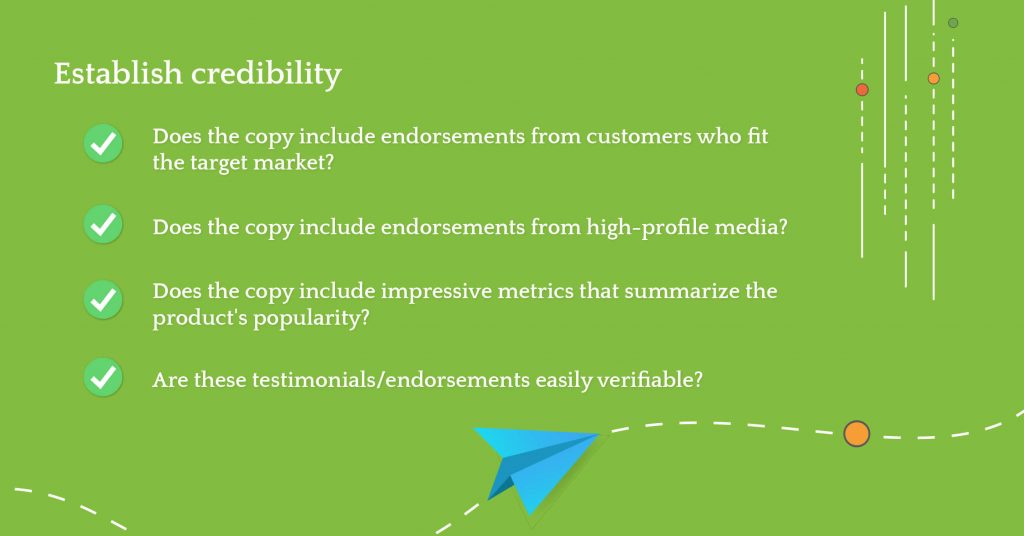
Address fears
Aside from establishing credibility, they also have to be vivid on what their offered service or product can achieve for you once you make a purchase. Remember: the reason people buy from a provider is that they believe that the product can help address their pain point and achieve the desired goal. Evaluate the heuristic principles of how a website you’re assessing is able to address this conversion requirement goal.
These are the following checklist items to answer for this conversion requirement goal:
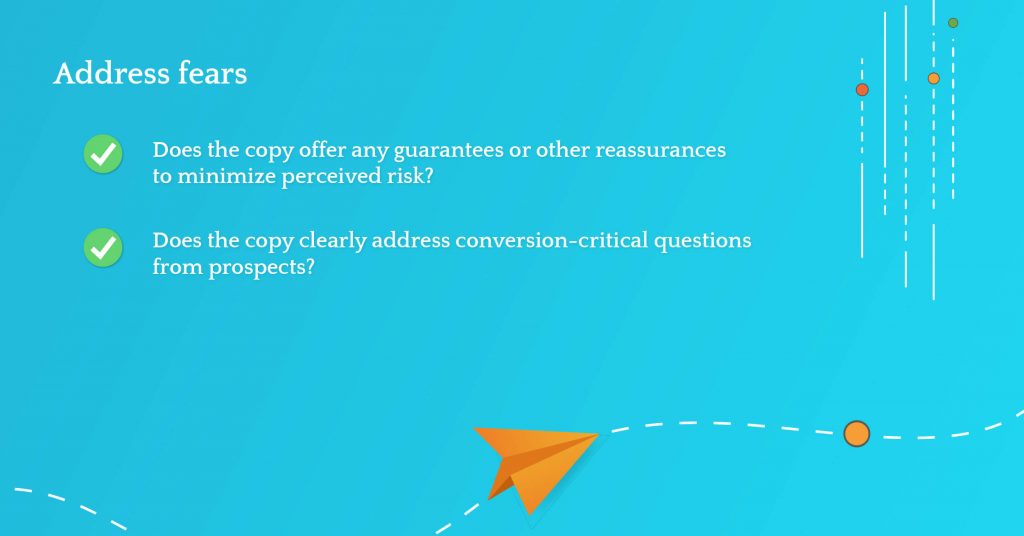
Present the offer
The pièce de résistance of a website is its ability to turn any onlooker into a potential lead and conversion. To do that, there has to be a visible and dominant web feature that elicits and persuades the user to purchase what a provider has to offer. It all boils down to how unified a website’s CTA and intent is for a customer to perform a profitable action.
What evaluators are trying to determine here is if the website consciously maximizes the value of its offer vis-a-vis their information architecture and pricing. Carefully review how a website presents their offer to a user as they approach the end of a sales funnel.
These are the following checklist items to answer for this conversion requirement goal:
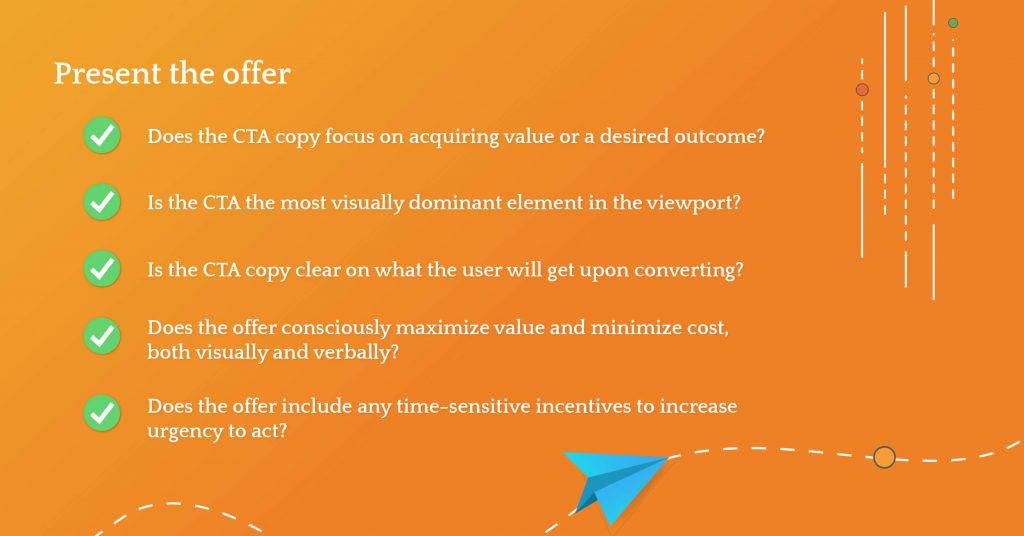
Form design
As an added conversion requirement goal, you also have to look at how a website presents its form design. This matters because there are cases that a user is already on the brink of converting but because a contact sheet or sales form is absent or has poor responsive design it can keep them from doing so. This puts to waste all the hard effort you put into creating a robust website only to lose a sale because of a lousy ‘Contact us’ page.
These are the following checklist items to answer for this conversion requirement goal:
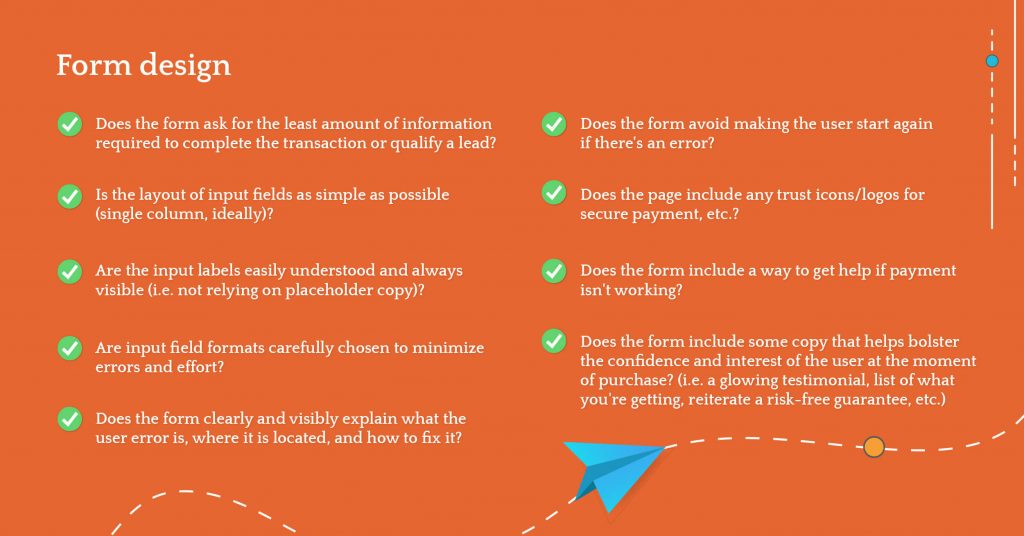
Conclusion
When developing your brand’s product messaging, it’s important to keep these conversion requirement goals in mind because it grants you foresight on essential features that make a website effective in generating leads and converting users.
As for copywriting, you’ll get to see the themes and frameworks that your top competitors use for their copies and review if it is effective in satisfying the set heuristics. This data allows you to know what copies to write, veer away from, and improve on your website.
You don’t have to look elsewhere anymore or conduct exhaustive research on your competitors because a heuristic evaluation already establishes set criteria to determine the effectiveness of a website’s product messaging. Not only that, but you can perform the heuristic analysis on your existing pages to optimize areas for improvement on your website.
Include this in your brand’s digital marketing arsenal to gather vital insights that can improve the positioning of your brand’s offered products and services the next time a user enters your website.
Key Takeaways
To sum up the key points of this article on heuristic evaluation for product messaging and copywriting:
- It’s important that the SMEs who will conduct the review are adept or have a firm background in SEO, UX design, content marketing, copywriting, and product messaging. The worth of the heuristic evaluation will rely on their expertise and experience in these digital disciplines.
- When reviewing the websites (including yours), make sure that the page type and search intent are aligned with each other. The last thing you want is to gather insights from pages that have inaccurate comparisons.
- Keep in mind that since this is an expert review there has to be a degree of inter-rater agreement between the evaluators. Therefore if the scores do not satisfy the Fleiss’ Kappa correlation then the integrity of the heuristic evaluation is questionable. This data-driven approach answers the whole credibility clause of the analysis, therefore making the insights valid.
Since we mentioned earlier that heuristic evaluation is quite a broad topic branching out to different digital disciplines, stay tuned for more data-driven discussions we have in store for you, only here at Propelrr.
Any thoughts or insights you’d like to add for heuristic evaluation? Share it in the comments below or better yet, talk to us over at Facebook, X, or LinkedIn. We'd be glad to hear what you have to say!
